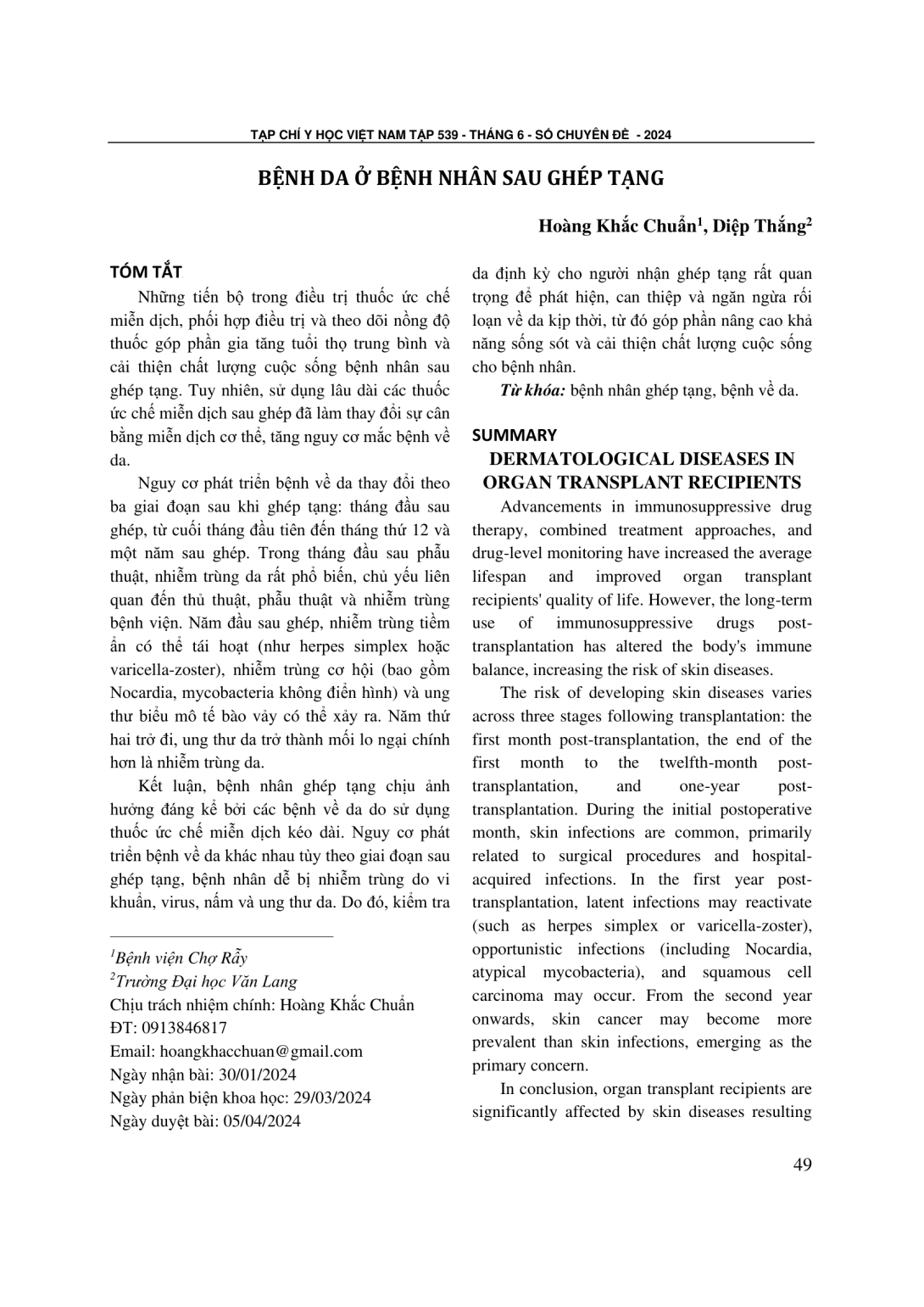
Những tiến bộ trong điều trị thuốc ức chế miễn dịch, phối hợp điều trị và theo dõi nồng độ thuốc góp phần gia tăng tuổi thọ trung bình và cải thiện chất lượng cuộc sống bệnh nhân sau ghép tạng. Tuy nhiên, sử dụng lâu dài các thuốc ức chế miễn dịch sau ghép đã làm thay đổi sự cân bằng miễn dịch cơ thể, tăng nguy cơ mắc bệnh về da. Nguy cơ phát triển bệnh về da thay đổi theo ba giai đoạn sau khi ghép tạng: tháng đầu sau ghép, từ cuối tháng đầu tiên đến tháng thứ 12 và một năm sau ghép. Trong tháng đầu sau phẫu thuật, nhiễm trùng da rất phổ biến, chủ yếu liên quan đến thủ thuật, phẫu thuật và nhiễm trùng bệnh viện. Năm đầu sau ghép, nhiễm trùng tiềm ẩn có thể tái hoạt (như herpes simplex hoặc varicella-zoster), nhiễm trùng cơ hội (bao gồm Nocardia, mycobacteria không điển hình) và ung thư biểu mô tế bào vảy có thể xảy ra. Năm thứ hai trở đi, ung thư da trở thành mối lo ngại chính hơn là nhiễm trùng da. Kết luận, bệnh nhân ghép tạng chịu ảnh hưởng đáng kể bởi các bệnh về da do sử dụng thuốc ức chế miễn dịch kéo dài. Nguy cơ phát triển bệnh về da khác nhau tùy theo giai đoạn sau ghép tạng, bệnh nhân dễ bị nhiễm trùng do vi khuẩn, virus, nấm và ung thư da. Do đó, kiểm tra da định kỳ cho người nhận ghép tạng rất quan trọng để phát hiện, can thiệp và ngăn ngừa rối loạn về da kịp thời, từ đó góp phần nâng cao khả năng sống sót và cải thiện chất lượng cuộc sống cho bệnh nhân.
Advancements in immunosuppressive drug therapy, combined treatment approaches, and drug-level monitoring have increased the average lifespan and improved organ transplant recipients' quality of life. However, the long-term use of immunosuppressive drugs post-transplantation has altered the body's immune balance, increasing the risk of skin diseases. The risk of developing skin diseases varies across three stages following transplantation: the first month post-transplantation, the end of the first month to the twelfth-month post-transplantation, and one-year post-transplantation. During the initial postoperative month, skin infections are common, primarily related to surgical procedures and hospital-acquired infections. In the first year post-transplantation, latent infections may reactivate (such as herpes simplex or varicella-zoster), opportunistic infections (including Nocardia, atypical mycobacteria), and squamous cell carcinoma may occur. From the second year onwards, skin cancer may become more prevalent than skin infections, emerging as the primary concern. In conclusion, organ transplant recipients are significantly affected by skin diseases resulting from prolonged use of immunosuppressive drugs. The risk of developing various skin diseases varies across post-transplantation stages, with patients susceptible to infections caused by bacteria, viruses, fungi, and skin cancers. Therefore, regular dermatological checks for transplant recipients are crucial for timely detection, intervention, and prevention of skin disorders, thereby improving survival rates and enhancing the quality of life for organ transplant recipients.
- Đăng nhập để gửi ý kiến
